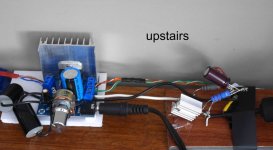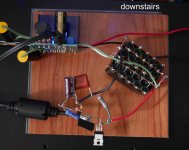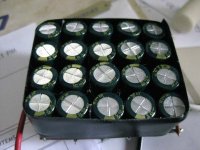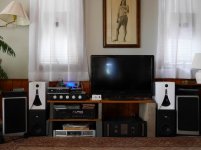Good catch Mboxler. That PCB is labeled backwards. Looking at the bottom, the red wire is connected to the ground plane.
Mark, I would normally use a DVM and connect the red lead to the positive and black lead to negative on your board. As you had it wired, the DVm would have said +12v (or whatever your PSU is). But the next step is to take it all the way to the IC. You would need to look up the pinouts. IIRC, it's the pins farthest in left and right are the positive power supply input pins. If you measured here - you would have gotten -12v on your Dvm.
Glad it's working now.
Mark, I would normally use a DVM and connect the red lead to the positive and black lead to negative on your board. As you had it wired, the DVm would have said +12v (or whatever your PSU is). But the next step is to take it all the way to the IC. You would need to look up the pinouts. IIRC, it's the pins farthest in left and right are the positive power supply input pins. If you measured here - you would have gotten -12v on your Dvm.
Glad it's working now.
Hi X and Mboxler,
Yeah, I was wondering if the board was mis-labeled. I considered that possibility yesterday in the middle of all this, but I was reluctant to switch the leads...afraid of blowing the chip. But then, XRK gave me the confidence to do it.
So many of these Chinese boards have labeling errors, and I supposed that's one reason they are sold cheaply on eBay.
Thanks for the education fellows. It's greatly appreciated. X, yes, I was getting +12.66 volts when I hooked up the meter as you indicated above. That's what was puzzling me. I expected that if I had the jack mis-wired I would have been reading a -12.66 volts. And yes, had I not got the thing working I would have had to "dig in" and try to determine which pin(s) on the chip to take a reading. (That's where I would have really been over my head without you guys! Ha!)
Many thanks.
Mark
Yeah, I was wondering if the board was mis-labeled. I considered that possibility yesterday in the middle of all this, but I was reluctant to switch the leads...afraid of blowing the chip. But then, XRK gave me the confidence to do it.
So many of these Chinese boards have labeling errors, and I supposed that's one reason they are sold cheaply on eBay.
Thanks for the education fellows. It's greatly appreciated. X, yes, I was getting +12.66 volts when I hooked up the meter as you indicated above. That's what was puzzling me. I expected that if I had the jack mis-wired I would have been reading a -12.66 volts. And yes, had I not got the thing working I would have had to "dig in" and try to determine which pin(s) on the chip to take a reading. (That's where I would have really been over my head without you guys! Ha!)
Many thanks.
Mark
The diode saved you from burning things up, as it blocked the reversed current. Now that the power supply is hooked up correctly, you should notice around .7 volt drop across the diode. I assume your PS is around 13.4 volts? I always replace the diode with a copper jumper, but this opens the chance to burn things up if the PS is wired backwards.
This is a great sounding amp that's also fun to learn on. Enjoy!
Mike
This is a great sounding amp that's also fun to learn on. Enjoy!
Mike
cap array question
question for xrk971:
as you know I just built a pair of XKiclops speakers using an old vifa 5" woofer, new PE tweeter and a box design you suggested. I had been auditioning it at my workstation driven by the cheapest TDA7297 I could find on ebay (caps replaced), an HP 19V adapter and Juma's Cap multiplier. The sound from that combo is KILLER. I procured a bag of 1000uF electrolytics to add a cap array in between the capMX and the amp, ostensibly to add bass impact, tho it already had everything I wanted. But the idea was to move these speakers downstairs to a medium sized room and get them off my desk. I picked up a Drok TDA7297 from amazon that was a bit pricier than the ebay ones I've gotten before. It's very similar except the input jack faces forward next to the volume control. I modded it w/ the same parts as b4, polypro input caps, shunt cap, and power cap. Built another Cap MX, and put together a cap array with 20 electrolytics wired in parallel. Hooked it all up with another HP 19V brick. When I started listening to the result it was kind of flat compared to what I was experiencing upstairs with a nearfield listening position. Downstairs I have the speakers on the floor to try and get best bass. It's OK but there's no real impact, and there is certainly not alot of bass. To see if it was the amp or something else, I brought the parts upstairs to see if the the cap array had a noticeable effect where I'm used to hearing the system. After hooking it all up and turning on, there was a terrible HUM and now the music signal was kind of weak. Odd that. Brought it downstairs and it worked fine again, tho not legendary. The upstairs interface to the input is a USB recording unit made by Roland, that connects to the amp and the computer. Downstairs there is a usb DAC interfacing with the computer then going thru an acurus preamp which is plugged into the TDA7297. I also brought the upstairs amp, cap mx and ps downstairs to try and it sounded similar to the other system w/ cap array. Any idea what's happening?
question for xrk971:
as you know I just built a pair of XKiclops speakers using an old vifa 5" woofer, new PE tweeter and a box design you suggested. I had been auditioning it at my workstation driven by the cheapest TDA7297 I could find on ebay (caps replaced), an HP 19V adapter and Juma's Cap multiplier. The sound from that combo is KILLER. I procured a bag of 1000uF electrolytics to add a cap array in between the capMX and the amp, ostensibly to add bass impact, tho it already had everything I wanted. But the idea was to move these speakers downstairs to a medium sized room and get them off my desk. I picked up a Drok TDA7297 from amazon that was a bit pricier than the ebay ones I've gotten before. It's very similar except the input jack faces forward next to the volume control. I modded it w/ the same parts as b4, polypro input caps, shunt cap, and power cap. Built another Cap MX, and put together a cap array with 20 electrolytics wired in parallel. Hooked it all up with another HP 19V brick. When I started listening to the result it was kind of flat compared to what I was experiencing upstairs with a nearfield listening position. Downstairs I have the speakers on the floor to try and get best bass. It's OK but there's no real impact, and there is certainly not alot of bass. To see if it was the amp or something else, I brought the parts upstairs to see if the the cap array had a noticeable effect where I'm used to hearing the system. After hooking it all up and turning on, there was a terrible HUM and now the music signal was kind of weak. Odd that. Brought it downstairs and it worked fine again, tho not legendary. The upstairs interface to the input is a USB recording unit made by Roland, that connects to the amp and the computer. Downstairs there is a usb DAC interfacing with the computer then going thru an acurus preamp which is plugged into the TDA7297. I also brought the upstairs amp, cap mx and ps downstairs to try and it sounded similar to the other system w/ cap array. Any idea what's happening?
Attachments
Try Drok amp upstairs without cap arrray. Check to make sure your cap array polarity is correct. How long does it take to charge up to steady state? What is the steady state voltage of cap array?
Then put cap array in upstairs but with old amp. Just try to eliminate as many potential problems as possible.
If one of your caps in the cap Mx is bad, it may present a short. In which case it will get hot and blow up. But when it is shorted - all power from PSU gets sucked low. Voltage will be low and it will sound weak and hum because cap multiplier is running fully open to keep up with current demand.
Look for a warm/hot cap with a bulging can lid. That's the bad one.
But these amps are so simple that when they don't work or don't sound good. It's the power supply. Is the wiring from cap array to amp correct polarity?
Then put cap array in upstairs but with old amp. Just try to eliminate as many potential problems as possible.
If one of your caps in the cap Mx is bad, it may present a short. In which case it will get hot and blow up. But when it is shorted - all power from PSU gets sucked low. Voltage will be low and it will sound weak and hum because cap multiplier is running fully open to keep up with current demand.
Look for a warm/hot cap with a bulging can lid. That's the bad one.
But these amps are so simple that when they don't work or don't sound good. It's the power supply. Is the wiring from cap array to amp correct polarity?
Thanks for the reply X. I already tried the cap array and new MX with the old amp upstairs. Drok too. That's what is mostly hum. All the polarity is correct. The polarities for V+ and speakers are switched on the two amps. But I hook them up carefully. The new MX and array work fine on the new speakers downstairs with Drok(played this combo for hours this morning) or old amp, just doesn't have a very noticeable difference than w/o cap array. Voltage after cap array is just over 16V. When switched on it takes 1-2 seconds for LED to light on amp, seems to ramp up nicely. When switched off, it takes a few seconds for the LED to fade and then there's a noticeable scratchy noise, not really a pop. The caps all look OK. Also everything is cool to the touch. I'm thinking something to do w/ ground and the upstairs usb interface? pic of caps and recording of hum (also w/music) attached.
Attachments
Apologies if I've missed some information.
Can someone explain in layman's terms what that capacitor multiplier does?
I think I get the concept of the bank of multiple capacitors. That is supposed to increase bass response and reduce noise/smooth ripple? (Which I've never had a problem with in any chip amp I've experimented with.)
If you have a multi-capacitor bank, why would you need to multiply that effect?
Mark
Can someone explain in layman's terms what that capacitor multiplier does?
I think I get the concept of the bank of multiple capacitors. That is supposed to increase bass response and reduce noise/smooth ripple? (Which I've never had a problem with in any chip amp I've experimented with.)
If you have a multi-capacitor bank, why would you need to multiply that effect?
Mark
It multiplies the small 220uF cap preceding it by reducing ripple to an equivalent level as if the capacity was huge. So one way to reduce ripple is to use a large C in an CRC circuit. So imagine a CRC where C is like 1000x220uF. The ripple is very small and hence it's like having the C multiplied. The array uses caps in parallel to reduce equivalent series resistance. Low ESR caps like Oscons are expensive. A bank of 25 x 1000uF 60mOhm ESR caps is like 25mF 2.4mOhm cap which gives great bass response.
Thanks for the explanation
Hello there X,
Thanks for the education. I think I get the concepts.
Let's see:
1) So, the both of these (array and capacitor multiplier) act to, shall we say, improve the power supply (as opposed to the audio section) of these amps?
2) The small 220uF capacitor on the board is modified and made to increase in uF by the multiplier. Essentially, you've created a larger value CRC with this? Interesting.
3) And, as for the cap bank/array ...that mimics a much larger, and more expensive low ESR capacitor such as the Oscon you mentioned. And, the advantage of low ESR capacitors is they have lower resistance? So, I'm guessing the signal (current/voltage?) passes with greater speed/ease?
Now, since we use a switching type power supply which is already providing DCV why are these two devices necessary? Is it because those switching power supplies are really not that high quality?
Maybe I'm just lucky, or just can't hear, but I've never experienced problems with ringing or ?? that others report with switching power supplies. All the 7229 amps, the 31XX series amps, and the 7498 amps I have are dead quiet and sound really great.
A lot of rookie questions, I realize.......sorry for that. You're going to regret answering me!
Regards, and thanks,
Mark
It multiplies the small 220uF cap preceding it by reducing ripple to an equivalent level as if the capacity was huge. So one way to reduce ripple is to use a large C in an CRC circuit. So imagine a CRC where C is like 1000x220uF. The ripple is very small and hence it's like having the C multiplied. The array uses caps in parallel to reduce equivalent series resistance. Low ESR caps like Oscons are expensive. A bank of 25 x 1000uF 60mOhm ESR caps is like 25mF 2.4mOhm cap which gives great bass response.
Hello there X,
Thanks for the education. I think I get the concepts.
Let's see:
1) So, the both of these (array and capacitor multiplier) act to, shall we say, improve the power supply (as opposed to the audio section) of these amps?
2) The small 220uF capacitor on the board is modified and made to increase in uF by the multiplier. Essentially, you've created a larger value CRC with this? Interesting.
3) And, as for the cap bank/array ...that mimics a much larger, and more expensive low ESR capacitor such as the Oscon you mentioned. And, the advantage of low ESR capacitors is they have lower resistance? So, I'm guessing the signal (current/voltage?) passes with greater speed/ease?
Now, since we use a switching type power supply which is already providing DCV why are these two devices necessary? Is it because those switching power supplies are really not that high quality?
Maybe I'm just lucky, or just can't hear, but I've never experienced problems with ringing or ?? that others report with switching power supplies. All the 7229 amps, the 31XX series amps, and the 7498 amps I have are dead quiet and sound really great.
A lot of rookie questions, I realize.......sorry for that. You're going to regret answering me!
Regards, and thanks,
Mark
If you use a linear supply the cap multiplier helps reduce ripple and audible 60Hz line hum. In the case of a cap multiplier with SMPS it's serving another main purpose: to slowly ramp up startup current to prevent certain SMPS from thinking that the low ESR cap array is a dead short and shutting down protectively. Some high quality SMPS don't have a shutdown issue when used with cap arrays. But I like how if allows a graceful turn on that prevents speaker thump which would otherwise need a delay with a time delay circuit.
latest adventure in bigger bottom
Still fooling with the TDA7297/cap MX/cap array rig and trying to realize glory. I mounted a couple of PA130-8 woofers in the old boxes that originally had the VIFA woofers that were cannibalized for the the XKiclops build. The VIFAs sound much better in the foamcore boxes. And the old black boxes did experience a nice improvement in bass with the PA130's. However, neither system by itself driven by the chip rig had room filling impressive sound. Up close at a computer, awesome. I also tried the silver speakers which are my main monitors with hi end scan speak 7" and 1" drivers. Not real exciting, and they are capable of magnificent sound when driven by the Threshold Then I stumbled upon this combo- The black speakers and the XKiclops, stacked, hooked up together to the TDA7297 combo (~4 ohm load). I know, with the two pair of tweeters it should be some kind of listening hell, but it's not. It's huge. There is tremendous bottom. It's room filling. The imaging is OK. Even the stoic indian (a charcoal sketch by my grandma in art school) is digging it.
Then I stumbled upon this combo- The black speakers and the XKiclops, stacked, hooked up together to the TDA7297 combo (~4 ohm load). I know, with the two pair of tweeters it should be some kind of listening hell, but it's not. It's huge. There is tremendous bottom. It's room filling. The imaging is OK. Even the stoic indian (a charcoal sketch by my grandma in art school) is digging it.
Still fooling with the TDA7297/cap MX/cap array rig and trying to realize glory. I mounted a couple of PA130-8 woofers in the old boxes that originally had the VIFA woofers that were cannibalized for the the XKiclops build. The VIFAs sound much better in the foamcore boxes. And the old black boxes did experience a nice improvement in bass with the PA130's. However, neither system by itself driven by the chip rig had room filling impressive sound. Up close at a computer, awesome. I also tried the silver speakers which are my main monitors with hi end scan speak 7" and 1" drivers. Not real exciting, and they are capable of magnificent sound when driven by the Threshold
Attachments
We have all read about the K's ability to fill the room with music. My room however, is small and acoustically very poor. So I started moving my K's according to near field positioning by 29% ratio, there's a website that has an automatic calculator for this, and it works really nice. Just sharing in case you have a bad room like mine, near field can be the way to go.
- Home
- Amplifiers
- Chip Amps
- What the heck? It's less than lunch!



